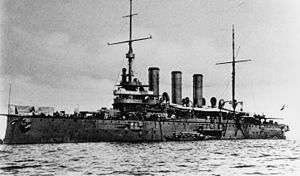List of cruisers of Austria-Hungary
Between the 1870s and 1910s, the Austro-Hungarian Navy built a series of cruisers of various types, including small torpedo cruisers, protected cruisers, fast scout cruisers and large armored cruisers. The first modern cruisers were the three Zara class begun in the late 1870s; a fourth vessel, Lussin, followed in the early 1880s. These ships proved to be unsatisfactory in service, and so to gain experience building effective vessels, the Navy ordered the two Panther-class cruisers from Britain. These were used as the basis for the domestically-built Tiger. Toward the end of the 1880s, the Navy shifted from building small torpedo cruisers to larger protected and armored cruisers, the first of which were the two Kaiser Franz Joseph I-class cruisers. These provided the basis for the armored cruisers Kaiserin und Königin Maria Theresia, Kaiser Karl VI, and Sankt Georg, built between 1891 and 1905.
In the mid-1890s, the three Zenta-class cruisers were built; these proved to be the last protected cruisers of the Austro-Hungarian fleet. In the mid-1900s, the Navy started building scout cruisers, starting with Admiral Spaun, which proved to be a disappointment owing to her unreliable engines. The subsequent design, the Novara class, rectified the problem and they shouldered much of the burden of the Adriatic Campaign during World War I. They were the last class of cruisers completed before the war, as the Ersatz Zenta class was cancelled after the outbreak of hostilities, just two months after they had been authorized.
| Armament | The number and type of the primary armament |
|---|---|
| Armor | The thickness of the belt or deck armor |
| Displacement | Ship displacement at full combat load |
| Propulsion | Number of shafts, type of propulsion system, and top speed/horsepower generated |
| Service | The dates work began and finished on the ship and its ultimate fate |
| Laid down | The date the keel began to be assembled |
| Commissioned | The date the ship was commissioned |
Torpedo cruisers
Zara class
| Ship | Armament | Armor | Displacement | Propulsion | Service | ||
|---|---|---|---|---|---|---|---|
| Laid down | Commissioned | Fate | |||||
| SMS Zara | 4 × 9 cm (3.5 in) guns 3 × 35 cm (14 in) torpedo tubes[1] |
— | 838 t (825 long tons; 924 short tons)[1] | Ceded to Italy as a war prize, scrapped in 1920[1] | |||
| SMS Spalato | |||||||
| SMS Sebenico | 4 × 9 cm guns 1 × 35 cm torpedo tube[1] |
882.6 t (868.7 long tons; 972.9 short tons)[1] | |||||
Lussin
| Ship | Armament | Armor | Displacement | Propulsion | Service | ||
|---|---|---|---|---|---|---|---|
| Laid down | Commissioned | Fate | |||||
| SMS Lussin | 4 × 15 cm (5.9 in) guns 1 × 35 cm torpedo tube[1] |
— | 995.25 t (979.53 long tons; 1,097.08 short tons) [1] | Ceded to Italy as a war prize, commissioned as Sorrento, scrapped after 1928[2] | |||
Panther class

| Ship | Armament | Armor | Displacement | Propulsion | Service | ||
|---|---|---|---|---|---|---|---|
| Laid down | Commissioned | Fate | |||||
| SMS Panther | 4 × 12 cm guns 4 × 35.6 cm (14 in) torpedo tubes[3] |
Deck: 12 mm (0.47 in)[3] | 1,557 t (1,532 long tons; 1,716 short tons)[3] | Two compound steam engines, 18.4 to 18.7 knots (34.1 to 34.6 km/h; 21.2 to 21.5 mph)[3] | 29 October 1884[3] | 31 December 1885[3] | Ceded to Britain as a war prize, scrapped in 1920[3] |
| SMS Leopard | January 1885[3] | 31 March 1886[3] | Ceded to Britain as a war prize, scrapped in 1920[3] | ||||
Tiger
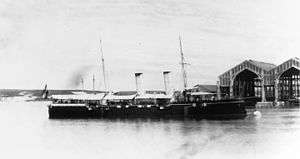
| Ship | Armament | Armor | Displacement | Propulsion | Service | ||
|---|---|---|---|---|---|---|---|
| Laid down | Commissioned | Fate | |||||
| SMS Tiger | 4 × 12 cm guns 4 × 35 cm torpedo tubes[4] |
— | 1,657 to 1,680 t (1,631 to 1,653 long tons; 1,827 to 1,852 short tons)[4] | Two compound steam engines, 18.56 knots (34.37 km/h; 21.36 mph)[4] | 5 October 1886[4] | March 1888[4] | Ceded to Italy as a war prize, scrapped in 1920[4] |
Protected cruisers
Kaiser Franz Joseph I class
| Ship | Armament | Armor | Displacement | Propulsion | Service | ||
|---|---|---|---|---|---|---|---|
| Laid down | Commissioned | Fate | |||||
| SMS Kaiser Franz Joseph I | 2 × 24 cm K L/35 guns[4] | Belt: 57 mm (2.2 in)[4] | 4,494 t (4,423 long tons; 4,954 short tons)[4] | Two triple-expansion engines, 19 kn (35 km/h; 22 mph)[4] | 3 January 1888[4] | 2 July 1890[4] | Ceded to France as a war prize, foundered in 1919[4] |
| SMS Kaiserin Elisabeth | July 1888[4] | 21 January 1892[4] | Scuttled in Tsingtao, 2 November 1914[4] | ||||
Zenta class
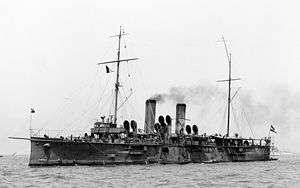
| Ship | Armament | Armor | Displacement | Propulsion | Service | ||
|---|---|---|---|---|---|---|---|
| Laid down | Commissioned | Fate | |||||
| SMS Zenta | 8 × 12 cm (4.7 in) guns[4] | Belt: 25 mm (0.98 in)[4] | 2,503 to 2,625 t (2,463 to 2,584 long tons; 2,759 to 2,894 short tons)[4] | Two triple expansion engines, 20.8 kn (38.5 km/h; 23.9 mph)[4] | 8 August 1896[4] | 28 May 1899[4] | Sunk at the Battle of Antivari, 16 August 1914[4] |
| SMS Aspern | 4 October 1897[4] | 29 May 1900[4] | Ceded to Britain as a war prize, scrapped in 1920[4] | ||||
| SMS Szigetvár | 25 May 1899[4] | 30 September 1901[4] | |||||
Armored cruisers
Kaiserin und Königin Maria Theresia

Following the Kaiser Franz Joseph I class of protected cruisers, the Austro-Hungarian Navy decided to build more powerful ships, the first of which became the armored cruiser Kaiserin und Königin Maria Theresia. The new ship was intended to fill some of the roles of a battleship. The Navy solicited designs from five British shipyards, but ultimately awarded the contract to the domestic firm Stabilimento Tecnico Triestino. The ship was initially to be armed with a battery of six 15 cm (5.9 in) guns, but the armament was increased by two of those guns, along with a pair of 24-centimeter (9.4 in) guns.[5]
Early in the ship's career, she was frequently sent abroad, including a trip to Germany for the opening of the Kaiser Wilhelm Canal in 1895.[6] In 1898, she was sent to Cuba to evacuate Austro-Hungarian nationals during the Spanish–American War; while there, she was nearly attacked by American warships who mistook her for the similarly-named Spanish cruiser Infanta Maria Teresa.[7] She participated in the European suppression of the Boxer Rebellion in China in 1901.[8] During World War I she was used as a guard ship in Sebenico until 1916, when she became a barracks ship. After Austria-Hungary's defeat, she was awarded to Britain as a war prize and was broken up for scrap in 1920.[9]
| Ship | Armament | Armor | Displacement | Propulsion | Service | ||
|---|---|---|---|---|---|---|---|
| Laid down | Commissioned | Fate | |||||
| SMS Kaiserin und Königin Maria Theresia | 2 × 24 cm (9.4 in) K L/35 guns[5] | Belt: 100 mm (3.9 in)[5] | 6,026 t (5,931 long tons; 6,643 short tons)[5] | Two triple-expansion engines, 19.35 knots (36 km/h; 22 mph)[5] | 1 July 1891[5] | November 1894[5] | Ceded to Britain as a war prize, scrapped in 1920[5] |
Kaiser Karl VI
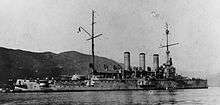
The follow-on to Kaiserin und Königin Maria Theresia was based heavily on that ship, the primary improvements being significantly strengthened armor protection and a newer model of 24 cm gun, along with more powerful machinery that gave a knot and a half increase in speed.[5]
Kaiser Karl VI served with the main fleet for the majority of her active career. In 1910, she made a major trans-Atlantic cruise to represent Austria-Hungary at Brazil's centennial celebration of the country's independence.[10] During World War I, the ship participated in the defense of Cattaro Bay, which included a length artillery duel between Kaiser Karl VI and other Austro-Hungarian warships and Montenegrin and French artillery batteries in the heights around the port.[11] Kaiser Karl VI was at the center of the Cattaro Mutiny in January 1918 that culminated in the execution of four of the ringleaders,[12] along with the decommissioning of Kaiser Karl VI and the dispersal of her restive crew. Like her predecessor, she was awarded to Britain after the war and sold for scrap in Italy.[13]
| Ship | Armament | Armor | Displacement | Propulsion | Service | ||
|---|---|---|---|---|---|---|---|
| Laid down | Commissioned | Fate | |||||
| SMS Kaiser Karl VI | 2 × 24 cm K L/40 guns[5] | Belt: 220 mm (8.7 in)[5] | 6,864 t (6,756 long tons; 7,566 short tons)[5] | Two triple-expansion engines, 20.83 knots (38.58 km/h; 23.97 mph)[5] | 1 June 1896[5] | 23 May 1900[5] | Ceded to Britain as a war prize, scrapped in 1920[5] |
Sankt Georg
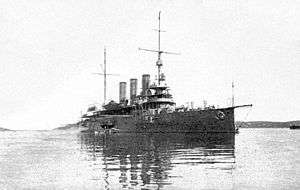
The third and final armored cruiser, Sankt Georg, was another iterative improvement on the previous vessels. The ship carried a much more powerful secondary battery that included five 19 cm (7.5 in) guns in place of four of the 15 cm guns. She also had new engines that gave her over a knot increase in speed over Kaiser Karl VI.[5]
Like her predecessor, Sankt Georg served with the fleet for the bulk of her career. In 1907, she visited the United States with the protected cruiser Aspern.[10] During World War I, she was based in Cattaro with the most modern cruisers of the fleet, though she was too slow to take an active role in the raids against Entente forces.[14] She sortied in May 1917 to rescue the three Novara-class cruisers during the Battle of the Strait of Otranto; her appearance forced the British and Italian vessels pursuing the Novaras to break off the chase.[15] Sankt Georg was also involved in the Cattaro Mutiny, during which her captain was killed by the mutineers.[16] After the war, she was surrendered to Britain and scrapped in Italy.[5]
| Ship | Armament | Armor | Displacement | Propulsion | Service | ||
|---|---|---|---|---|---|---|---|
| Laid down | Commissioned | Fate | |||||
| SMS Sankt Georg | 2 × 24 cm K L/40 guns[5] | Belt: 210 mm (8.3 in)[5] | 8,070 t (7,940 long tons; 8,900 short tons)[5] | Two triple-expansion engines, 22 knots (41 km/h; 25 mph)[5] | 11 March 1901[5] | 21 July 1905[5] | Ceded to Britain as a war prize, scrapped in 1920[5] |
Scout cruisers
Admiral Spaun
In the early 1900s, Austria-Hungary entered a brief hiatus in cruiser construction; on 1 May 1906, a set of design requirements was issued for a new design. The ship was to displace 3,500 t (3,400 long tons; 3,900 short tons) normally, and should be faster than contemporary cruisers of foreign navies. It should also have slightly better armor protection, which necessitated a weaker armament. The design, which was finalized by 1908, also incorporated steam turbines, the first time the new type of engines were used in a major Austro-Hungarian warship.[17]
Admiral Spaun's turbines proved to be very difficult in service, which greatly reduced her activity during the war. Without a reliable propulsion system, she could not join the three Novaras on their raids in the southern Adriatic, but she still saw action in less dangerous operations. After the war, she was ceded to Britain for reparations and was broken up in Italy in 1920.[17]
| Ship | Armament | Armor | Displacement | Propulsion | Service | ||
|---|---|---|---|---|---|---|---|
| Laid down | Commissioned | Fate | |||||
| SMS Admiral Spaun | 7 × 10-centimeter (3.9 in) guns[17] | Belt: 60 mm (2.4 in)[17] | 4,000 t (3,900 long tons; 4,400 short tons)[17] | Six steam turbines, 27.07 kn (50.13 km/h; 31.15 mph)[17] | 30 May 1908[17] | 15 November 1910[17] | Ceded to Britain as a war prize, scrapped in 1920[17] |
Novara class
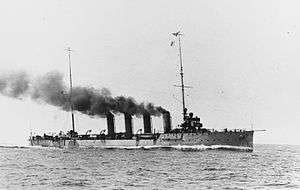
The next three cruisers built by Austria-Hungary were iterative developments of Admiral Spaun, the primary improvements being more powerful turbines that allowed fewer engines to be used and a strengthened gun battery. The weight savings from the reduced number of turbines was also used to reinforce the hull structure. Unlike Admiral Spaun, the Novaras' engines were very reliable and provided a high speed that proved to be very useful during the war. As a result, they formed the backbone of the naval war in the Adriatic, conducting a number of raids against enemy forces in the southern Adriatic.[17] These culminated in the Battle of the Strait of Otranto in May 1917, the largest naval battle of the Adriatic Campaign.[18]
After the war, all three ships were surrendered to the Entente, with Saida and Helgoland going to Italy as Venezia and Brindisi, respectively, and Novara to France as Thionville. They served in the navies of their respective owners into the early 1930s, when they were withdrawn from service, thereafter being used for subsidiary duties. The two Italian ships were scrapped in 1937, but Thionville survived as a barracks ship until 1941, when she too was broken up.[17]
| Ship | Armament | Armor | Displacement | Propulsion | Service | ||
|---|---|---|---|---|---|---|---|
| Laid down | Commissioned | Fate | |||||
| SMS Saida | 9 × 10 cm guns[17] | Belt: 60 mm[17] | 4,017 t (3,954 long tons; 4,428 short tons)[17] | Two steam turbines, 27 knots (50 km/h; 31 mph)[17] | 9 September 1911[17] | 1 August 1914[17] | Ceded to Italy as a war prize, commissioned as Venezia, scrapped in 1937[17] |
| SMS Helgoland | 28 October 1911[17] | 5 September 1914[17] | Ceded to Italy as a war prize, commissioned as Brindisi, scrapped in 1937[17] | ||||
| SMS Novara | 9 December 1912[17] | 10 January 1915[17] | Ceded to France as a war prize, commissioned as Thionville, scrapped in 1941[17] | ||||
Light cruisers
Ersatz Zenta class
On 28 May 1914, the annual naval budget was approved by the Austro-Hungarian parliaments; the budget included funding for three new cruisers to replace the Zentas,[19] which had by this time become obsolescent.[4] The new ships were based on experience gained from the preceding Novara-class cruisers, though a greater emphasis was placed on armament, with a greater number and caliber of main guns. The outbreak of World War I just two months after their authorization delayed their laying down, which had been scheduled for 1 July 1914 for the first unit, "K". The other two were to have followed on 1 July 1915, but work never began on any of the ships.[19]
In December 1915, the Navy's high command requested that the design be reworked to incorporate wartime experience. The design was radically changed, with the original 12 cm guns replaced with a pair of 19 cm (7.5 in) guns and six 15 cm (5.9 in) guns. Belt armor was also considerably strengthened, to 150 mm (5.9 in). Work never started on the new design either, as most of the shipyard workers who were to have built them had been drafted into the Austro-Hungarian Army.[19]
| Ship | Armament | Armor | Displacement | Propulsion | Service | ||
|---|---|---|---|---|---|---|---|
| Laid down | Commissioned | Fate | |||||
| K | 14 × 12 cm guns[19] | Belt: 20 mm (0.79 in)[19] | 5,611 t (5,522 long tons; 6,185 short tons)[19] | Two steam turbines, 30.1 kn (55.7 km/h; 34.6 mph)[19] | — | — | Work never begun[19] |
| L | |||||||
| M | |||||||
See also
Notes
- 1 2 3 4 5 6 7 Gardiner & Gray, p. 331
- ↑ Gardiner & Gray, p. 290
- 1 2 3 4 5 6 7 8 9 10 Gardiner, p. 277
- 1 2 3 4 5 6 7 8 9 10 11 12 13 14 15 16 17 18 19 20 21 22 23 24 25 26 27 28 29 Gardiner, p. 278
- 1 2 3 4 5 6 7 8 9 10 11 12 13 14 15 16 17 18 19 20 21 22 23 24 25 Gardiner, p. 273
- ↑ Sondhaus, p. 131
- ↑ Greger (1980), pp. 61–62
- ↑ Sondhaus, p. 140
- ↑ Gardiner & Gray, p. 331
- 1 2 Sondhaus, p. 185
- ↑ Noppen, pp. 28–30
- ↑ Sondhaus, pp. 318–324
- ↑ Halpern, p. 171
- ↑ Sondhaus, p. 303
- ↑ Halpern (2004), pp. 91–97
- ↑ Sondhaus, pp. 318–324
- 1 2 3 4 5 6 7 8 9 10 11 12 13 14 15 16 17 18 19 20 21 22 23 24 Gardiner & Gray, p. 336
- ↑ Halpern, p. 162–166
- 1 2 3 4 5 6 7 8 Gardiner & Gray, p. 337
References
- Bilzer, Franz F. (1990). Die Torpedoschiffe und Zerstörer der k.u.k. Kriegsmarine 1867–1918. Graz: H. Weishaupt. ISBN 3900310661.
- Gardiner, Robert, ed. (1979). Conway's All the World's Fighting Ships: 1860–1905. London: Conway Maritime Press. ISBN 0-85177-133-5.
- Gardiner, Robert; Gray, Randal, eds. (1984). Conway's All the World's Fighting Ships: 1906–1921. Annapolis, MD: Naval Institute Press. ISBN 0-85177-245-5.
- Greger, René (1976). Austro-Hungarian Warships of World War I. London: Ian Allan. ISBN 978-0-7110-0623-2.
- Greger, René (1980). "The Austro-Hungarian Navy and the Spanish–American War of 1898". Warship International. International Naval Research Organization (1): 61–67.
- Sieche, Erwin (2002). Kreuzer und Kreuzerprojekte der k.u.k. Kriegsmarine 1889–1918 [Cruisers and Cruiser Projects of the Austro-Hungarian Navy, 1889–1918] (in German). Hamburg. ISBN 3-8132-0766-8.
- Sondhaus, Lawrence (1994). The Naval Policy of Austria-Hungary, 1867–1918. West Lafayette: Purdue University Press. ISBN 978-1-55753-034-9.
